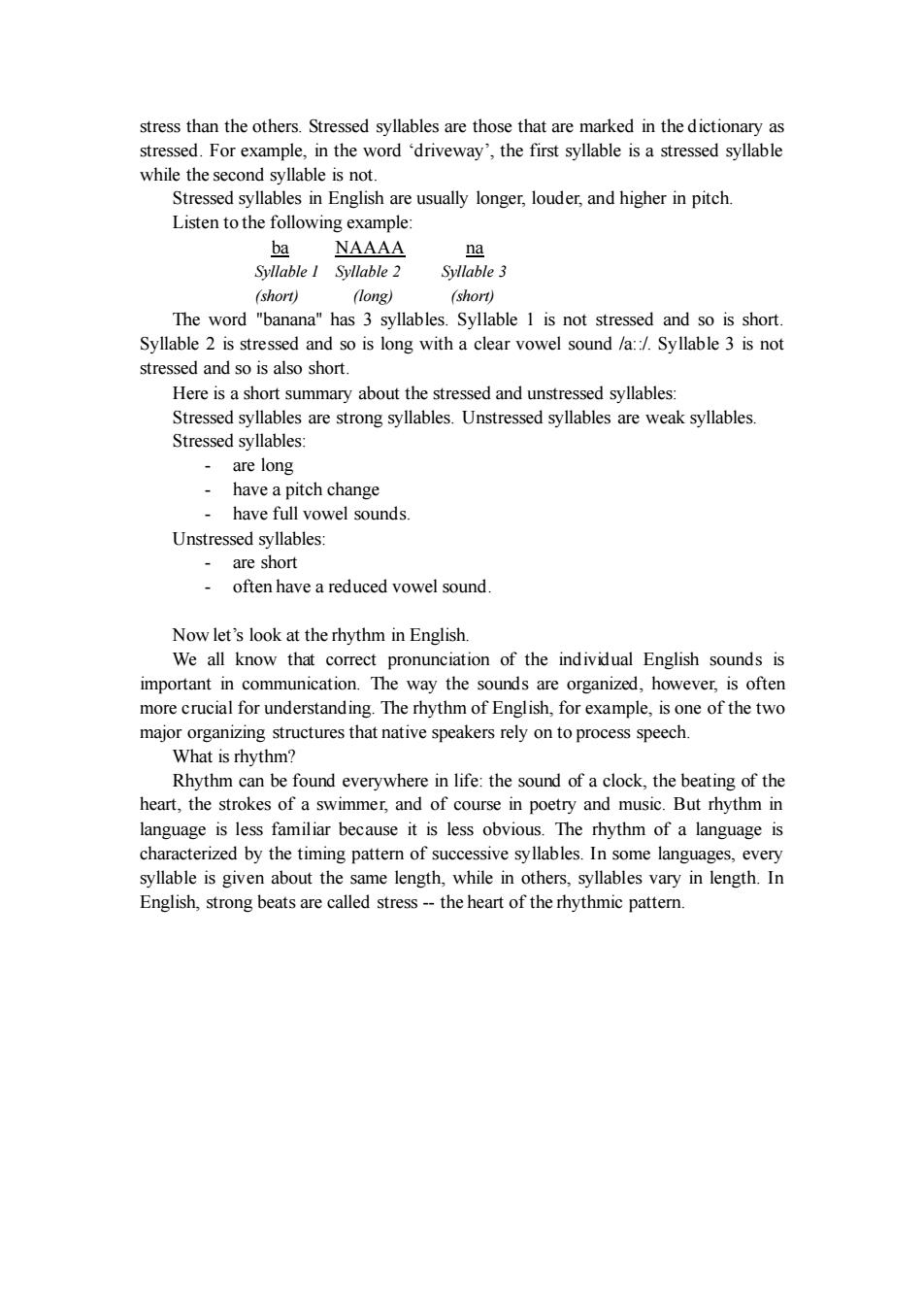正在加载图片...

stress than the others.Stressed syllables are those that are marked in the dictionar stressed.For exa mlin the word "dnveway the irst seisa stressed sy while the second syllable is not Stressed syllables in English are usually longer,louder,and higher in pitch. Listen to the following example: ha NAAAA Syllable 1 Syllable 2 (long) (short) The word "banana"has 3 syllables.Syllable 1 is not stressed and so is short Syllable 2 is stressed and so is long with a clear vowel sound /a::/.Syllable 3 is not stressed and so is also short. Here is a short summary about the stre ssed and unstressed syllables Stressed syllab es are strong syllables.Unstressed syllables are weak syllables Stressed syllables are long have a pitch change have full vowel sounds Unstressed syllables are shon often have a reduced vowel sound Now let's look at the rhythm in English. We all know that e of the indivdual important in communication.The way the sounds s are organized. however,is often more crucial for understanding.The rhythm of English.for example.is one of the two major organizing structures that native speakers rely on to process speech. What is rhythm? Rhythm can be found in life:the sound of a beating of th heart,the strokes of a swimmer,and of course in poetry and music But rhythmn language is less familiar because it is less obvious.The rhythm of a language is characterized by the timing pattern of successive syllables.In some languages.every syllable is given about the same length,while in others,syllables vary in length.In English,strong beats are called stress-the heart of the rhythmic patterstress than the others. Stressed syllables are those that are marked in the dictionary as stressed. For example, in the word ‘driveway’, the first syllable is a stressed syllable while the second syllable is not. Stressed syllables in English are usually longer, louder, and higher in pitch. Listen to the following example: ba NAAAA na Syllable 1 Syllable 2 Syllable 3 (short) (long) (short) The word "banana" has 3 syllables. Syllable 1 is not stressed and so is short. Syllable 2 is stressed and so is long with a clear vowel sound /a::/. Syllable 3 is not stressed and so is also short. Here is a short summary about the stressed and unstressed syllables: Stressed syllables are strong syllables. Unstressed syllables are weak syllables. Stressed syllables: - are long - have a pitch change - have full vowel sounds. Unstressed syllables: - are short - often have a reduced vowel sound. Now let’s look at the rhythm in English. We all know that correct pronunciation of the individual English sounds is important in communication. The way the sounds are organized, however, is often more crucial for understanding. The rhythm of English, for example, is one of the two major organizing structures that native speakers rely on to process speech. What is rhythm? Rhythm can be found everywhere in life: the sound of a clock, the beating of the heart, the strokes of a swimmer, and of course in poetry and music. But rhythm in language is less familiar because it is less obvious. The rhythm of a language is characterized by the timing pattern of successive syllables. In some languages, every syllable is given about the same length, while in others, syllables vary in length. In English, strong beats are called stress - the heart of the rhythmic pattern